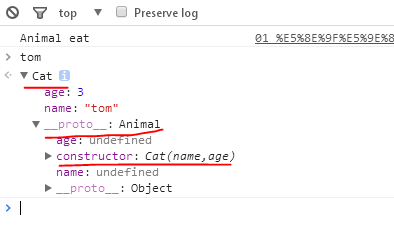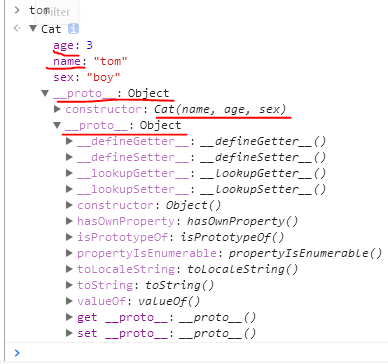一.原型链继承
关键步骤:
-
让子类的原型对象成为父类的实例
-
矫正子类构造器属性
1 function Animal(name,age){
2 this.name = name;
3 this.age = age;
4 }
5
6 Animal.prototype.eat = function(){
7 console.log("Animal eat");
8 }
9
10 function Cat(name,age){
11 this.name = name;
12 this.age = age;
13 }
14
15 //让子类的原型对象成为父类的实例
16 Cat.prototype = new Animal();
17
18 //当使用原型继承的时候,注意矫正子类的构造器属性
19 Cat.prototype.constructor = Cat;
20
21 var tom = new Cat('tom',3);
22 tom.eat();

二.借用构造函数继承
借用构造函数继承是伪继承:原型链上找不到父类的实例(son.__proto__..... != father.prototype)
1 function Animal(name, age) {
2 this.name = name;
3 this.age = age;
4 }
5 //子类没有继承父类的方法,子类原型链上找不到父类的实例为伪继承
6 Animal.prototype.eat = function () {
7 console.log("Animal eat");
8 }
9
10 function Cat(name, age, sex) {
11
12 //借用构造函数继承方式1
13 Animal.call(this, name, age);
14
15 //借用构造函数继承方式2
16 // Animal.apply(this, [name, age]);
17
18
19 this.sex = sex;
20 }
21
22
23 var tom = new Cat('tom', 3, 'boy');

三.组合继承:前两种方式加在一起
1 function Animal(name, age) {
2 this.name = name;
3 this.age = age;
4 }
5
6 Animal.prototype.eat = function () {
7 console.log("Animal eat");
8 }
9
10 function Cat(name, age, sex) {
11
12 //借用构造函数继承方式1
13 // Animal.call(this, name, age);
14
15 //借用构造函数继承方式2
16 Animal.apply(this, [name, age]);
17
18
19 this.sex = sex;
20 }
21
22 //让子类的原型对象成为父类的实例
23 Cat.prototype = new Animal();
24
25 //当使用原型继承的时候,注意矫正子类的构造器属性
26 Cat.prototype.constructor = Cat;
27
28
29 var tom = new Cat('tom', 3, 'boy');
30
31 console.log(tom)



